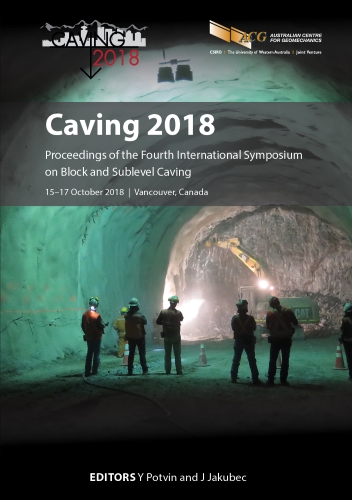Application of mathematical modelling for draw control under material flow uncertainty

|
Authors: Khodayari, F; Pourrahimian, Y; Ben-Awuah, E |
DOI https://doi.org/10.36487/ACG_rep/1815_64_Khodayari
Cite As:
Khodayari, F, Pourrahimian, Y & Ben-Awuah, E 2018, 'Application of mathematical modelling for draw control under material flow uncertainty', in Y Potvin & J Jakubec (eds), Caving 2018: Proceedings of the Fourth International Symposium on Block and Sublevel Caving, Australian Centre for Geomechanics, Perth, pp. 815-822, https://doi.org/10.36487/ACG_rep/1815_64_Khodayari
Abstract:
Production scheduling is one of the key steps in the decision-making process of any mining operation. In block caving, it is the choice of the amount of caved rock to extract from drawpoints in different periods. One of the main differences between block caving and other mining methods is the influence of the material flow on production, and draw control in general. Achieving an optimum production schedule without consideration of the cave rate and material flow could be unrealistic and impractical as the movements of material between drawpoints will result in unexpected production grades and tonnages. In this paper, a stochastic mixed integer optimisation model is proposed to optimise the production schedule during the life of the mine. The uncertainties of production grades and tonnages are captured by defining a number of scenarios that represent the probable movements of fragmented rock between drawpoints in the same neighbourhood. The decision variables in the formulation are based on the slice model, which means that the mathematical solution determines which slices are extracted from drawpoints in each period of production. The goal is to maximise the net present value of the project during the life of the mine and minimise the deviations of production grades and tonnages from the defined goals in all probable scenarios resulting from the movements of the fragmented rock between drawpoints. Application of the proposed model in caving operations can not only improve the profitability of the project, but also increase the confidence of the production schedule. MATLAB was used for programming and CPLEX for solving the model. The designed graphical user interface, with the capability of adding different technical and operational constraints, will be a flexible tool for mine planners to control the draw based on the company’s goals during the life of the mine.
Keywords: block caving, production scheduling, draw control, material flow, stochastic optimisation
References:
Diering, T 2004, ‘Computational considerations for production scheduling of block cave mines’, in A Karzulovic & MA Alfaro (eds), Proceedings of MassMin 2004, Instituto de Ingenieros de Chile, Santiago, pp. 135–140.
Khodayari, F & Pourrahimian, Y 2014, ‘Determination of the best height of draw in block cave sequence optimization’, in R Castro (ed.), Proceedings of the 3rd International Symposium on Block and Sublevel Caving, Universidad de Chile, Santiago,
pp. 457–465.
Khodayari, F & Pourrahimian, Y 2015a, ‘Determination of development precedence for drawpoints in block-cave mining’, in MP Nicolai (ed.), Proceedings of the 5th International Symposium: Mineral Resources and Mine Development, RWTH Aachen University, Aachen, pp. 383–391.
Khodayari, F & Pourrahimian, Y 2015b, ‘Mathematical programming applications in block-caving scheduling: a review of models and algorithms’, International Journal of Mining and Mineral Engineering, vol. 6, no. 3, pp. 234–257.
Khodayari, F & Pourrahimian, Y 2017, ‘Production scheduling in block caving with consideration of material flow’, Aspects in Mining and Mineral Science, vol. 1, no. 1.
Laubscher, DA 2000, A Practical Manual on Block Caving, prepared for International Caving Study, Julius Kruttschnitt Mineral Research Centre, Indooroopilly, and Itasca Consulting Group, Inc., Brisbane.
Pourrahimian, Y, Askari-Nasab, H & Tannant, D 2013, ‘A multi-step approach for block-cave production scheduling optimization’, International Journal of Mining Science and Technology, vol. 23, no. 5, pp. 739–750.
Rahal, D, Dudley, J & Hout, Gv 2008, ‘Developing an optimised production forecast at Northparkes E48 mine using MILP’,
in H Schunnesson & E Nordlund (eds), Proceeding of MassMin 2008, Luleå University of Technology, Luleå, pp. 227–236.
Rubio, E 2002, Long Term Planning of Block Caving Operations Using Mathematical Programming Tools, MSc thesis, The University of British Columbia, 126 p.
© Copyright 2025, Australian Centre for Geomechanics (ACG), The University of Western Australia. All rights reserved.
View copyright/legal information
Please direct any queries or error reports to repository-acg@uwa.edu.au
View copyright/legal information
Please direct any queries or error reports to repository-acg@uwa.edu.au
